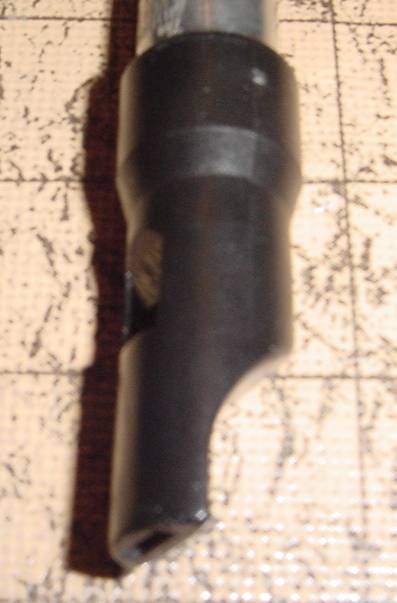Clarke Sweetone Soprano D whistle Review
(Review written September 2004)
- Preface
- The Sweetone was my first "favorite whistle". I started on a Clarke original--the kind with the wooden fipple block--and immediately set out to find a better whistle. I loved the way the Clarke sounded, but it was just so hard to play. I went through Shaws, Soodlums and a few others. When the Sweetone came out, I got one. I was in love! This was the whistle I was looking for: cheap, easy to play, and decent sounding. I played my first Sweetone for years before moving on to more expensive instruments.
- At a Glance
- Whistle Reviewed
- Clarke Sweetone Soprano D whistle
- Models Available
- soprano unfinished or in a variety of colors, keys of C and D
- How Acquired
- purchased from Melody Music
- Construction
- Rolled tinplate with a plastic mouthpiece.
- Price at Time of Review (in US Dollars unless otherwise noted)
- approx $6.00
- Available From
-
Lark in the Morning
The Whistle Shop
Melody Music and many more
- Appearance
- Almost all inexpensive whistles look nearly identical. Except for Clarkes, that is. The original Clarke whistle made in the 1840's was a piece of tinplate rolled and soldered around a wooden fipple block, producing a distinctive conical appearance. The Sweetone is the same design, replacing the wooden block and mouthpiece with a plastic mouthpiece designed by Michael Copeland (yes, of Copeland Woodwinds..king of the high-end tinwhistles)
-

Here is a plain unfinished Sweetone. I've had them in all kinds of colors...red, black, yellow, plain. Some people experience rusting on the plain ones..The only time I ever have was when I left one in the garage for a year in a rental house. That house layout was really weird, dumping the hot moist air from the drier exhaust directly into the garage. Not only did it eventually steam open every sealed box I had out there, it also eventually lightly rusted that whistle. I imagine that there'd have to be some extreme conditions to really rust something up...like putting it away wet or something. The Sweetone has a picture of "Whistling Billy" stamped on it. And to the best of my knowledge, Clarkes are the only real "made of tin" tinwhistle still made.
Here's the mouthpiece. It was designed, as I mentioned, by Michael Copeland. It's a little thicker than some, but fits comfortably in the mouth. Like all long-beaked whistles, I tend to bite on the mouthpiece. I think it's kind of strange that most inexpensive whistles have long beaks, and most expensive ones don't. The wind channel is squared and straight, and the labium ramp can be seen.
- Playing Characteristics
- This whistle has a pure character. It didn't sound as 'scratchy' to me as more pure-drop instruments sounded. It didn't sound airy like a Clarke original or a Shaw. It has just a tight little bit of chiff when tounging notes. The conical bore gives the whistle a good stability across it's range..no weak bell notes here!
-
Sound clips of the whistle:
Calliope House
Video clips of the whistle:
Glass of Beer (recorded 2017)Volume: This whistle is on the low side of medium. Just right for your average session. On a loud session, only the folks immediately next to you will hear you.
Responsiveness: I originally wrote that the response on these were fast. And they feel fast. But after recording myself, I have to downgrade the response to "moderate." Sweetones don't feel sluggish, but in general tend to sound less crisp on the fast execution of ornamentation like rolls and crans. They also sound less crisp on fiddle tunes that bounce back and forth between the first and second octave (like Drowsy Maggie, Glass of Beer or Tam Lin)
Tuning: The whistle isn't billed as tunable, but I found that the head was not glued on. Because of the soldered seam, it took a little work to get off, but not too much. With a little adjusting, the whistle was A=440. From there, it was in tune across the entire range. Another reason I fell in love with this little beauty.
C-natural: OXXOOO produces an in-tune c-natural.
Hole size and placement: This whistle has holes are average size and placement. There are no weird spacings. If you can play a soprano D, you can play this one.
Air volume and pressure requirements: This whistle's a very easy player. You can jump the octave easily, and it doesn't take much breath. In fact, this was the first whistle that I really enjoyed hitting the second octave on. Most old whistlers forget what it's like to be new, and dreading playing in the second octave. This whistle was really easy in that regard compared to the others I'd tried until then.
Clogging: This whistle is middle-of-the-road when it comes to clogging. It clogs after about 20 minutes, then I just blow it out and keep going. Plastic mouthpieced whistles are probably the easiest to maintain in this regard. It just never slowed me down much, and I played a Sweetone as my only instrument for years.
- Summary
- Excellent beginner's whistle. Easy to play, cheap if you break one--and I've broken a few! The fact that it's tinplate makes it a little fragile. I've bent a number of them by stepping on them, sitting on them, and bumping into doors. But they're pretty cheap and pretty consistent, so it's not like you have to keep hunting for a "good one" if you mess the one up you've got.